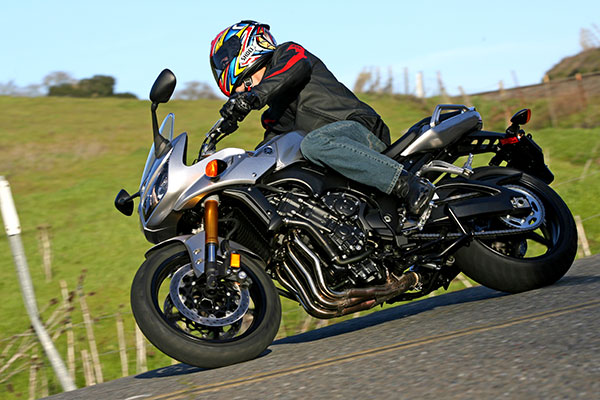
When I found out that I was headed to Santa Rosa, California to attend a press introduction for Yamaha’s all-new 2006 FZ1, I was understandably excited. After all, Sonoma and Napa counties have some of the finest riding I have found in California, and the spec sheet for the new FZ1 looked extremely impressive. Visions of twisty coastal roads and crazed hooligan-bike antics danced in my head as I tried to get to sleep the night before the intro.
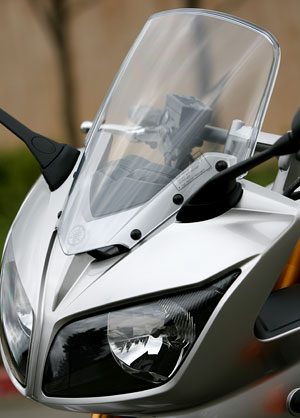
Unfortunately, mother nature decided to break into dreamland and slap me back to reality. Turned out that there was a nearly 100% chance of rain for the day we were scheduled to ride the bike – the photos you see in this article were taken during an hour-long photo session that we rushed to get done early in the evening on the day before the expected downpour.
The Monday of our ride dawned even wetter than I expected, and a few journalists floated the idea of spending the day in the bar or even heading back to our rooms to relax. But of course we all take seriously our obligation to our readers, and Yamaha’s thoughtful provision of waterproof oversuits for those riders who had failed to bring wet-weather gear helped entice us out onto the slick NorCal pavement. Luckily for this review, we somehow found about two hours of sunshine and semi-dry roads during our 7-hour riding day.
Back to that whole ‘spec sheet’ thing I mentioned earlier, though. Yamaha has thoroughly redesigned the FZ1 for 2006, a fact that is obvious as soon as you take a glance at the new machine. I don’t think I’m alone in admiring the new FZ1’s razor-sharp good looks – in fact, all the journalists present at the intro were in agreement that this is a very good-looking motorcycle.
Yamaha didn’t just change the FZ1’s appearance, however – this redesign went much deeper than that. Yamaha engineers started off with the 2006 R1 motor, and made a few changes with the objective of increasing the low-range performance compared to the R1, while producing more top-end power than the ’05 FZ1.
To accomplish this goal, they replaced the R1 camshafts with a newly-designed profile with slightly less valve lift, and added a redesigned crankshaft that has 33% more inertial mass than that of the R1.
The FZ1 now features an identical injection system to that found on the 06 R1 – meaning that 45mm throttle bodies replace the 37mm carbs found on the ’05 model. The new FZ1 exhales through a 4-2-1 exhaust system which features Yamaha’s EXUP valve as well as dual 3-way catalytic converters for compliance with strict Euro 3 emissions standards.
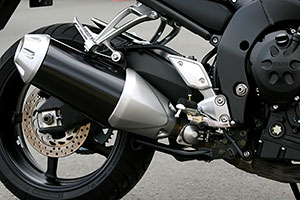
What does all this add up to? Yamaha claims that the ’06 FZ1 develops 148hp at 10,000 rpm, and 78.2 ft/lbs of torque at 8,000 rpm (both figures measured at the crank). This means that the new bike should produce the same torque as the ’05 model, but make 7hp more on the top end.
The FZ1 isn’t just packing an R1 motor – it uses the R1’s close-ratio six-speed gearbox as well. The only change is that 5th and 6th gear are slightly taller than on the R1 for a more relaxed character at freeway speeds.
Wrapped around the engine is an all-new, cast aluminum frame which is nearly 20lbs lighter than the steel frame found on the ’05 FZ1, and substantially more ridgid in every aspect (vertical, torsional, and horizontal). The rear wheel is carried by a new, longer aluminum swingarm which is produced using Yamaha’s ‘Controlled Fill’ die-casting process, which allows more precise control of wall thickness for a better stiffness/weight ratio. The longer swingarm is also claimed to provide improved power transfer and increased stability.
The new FZ1 was designed with what Yamaha calls a ‘mass-forward’ layout – the engine was moved as far forward as possible, resulting in a weight distribution of 51% front/49% rear, the same as the ’06 R1. This was done to provide better handling and stability as compared to the ’05 model, which carried 51.1% of its weight on the rear wheel and only 48.9% on the front.
The suspension duties are handled by 43mm USD Kayaba forks up front, and a Kayaba shock out back. The forks use an interesting design for their adjustment – one fork handles compression damping and the other takes care of rebound, both adjusters being found on the top of the fork (along with preload adjustment). Yamaha claims to have used the same style of adjustment on Valentino Rossi’s MotoGP bike with great success, which sounds like a fine pedigree to us. The shock is adjustable for rebound damping and preload only.
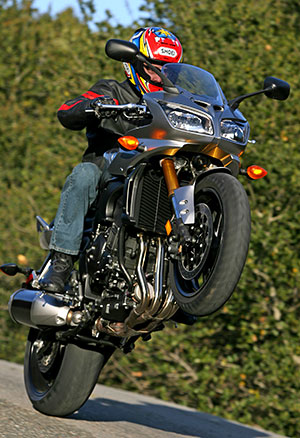
The brakes are similarly upgraded compared to the ’05 FZ1, and now feature basically the same components as the R1 – the only difference being that the front calipers are not radially mounted on the FZ1 as they are on the R1. The wheels are again similar to those found on the R1, and are quite a bit lighter than those on the previous FZ1 – a claimed 10% front and 8% rear.
Like the rest of the bike, the riding position has been revised in a slightly more sporty direction. The seat height has been reduced by 5mm to 815mm, and the entire riding position has been moved forward – likely with the intent to maintain the ‘mass-forward’ setup even with a rider on board. The bars are 25mm lower and 10mm closer than on the ’05 bike, while the footpegs are 27mm further back and 16mm higher.
Now that you know how Yamaha redesigned the FZ1 for ’06, you are probably asking an important question – is it a significant improvement over the previous-generation FZ1, which has been extremely popular since it’s release several years ago? The short answer to this question is: yes and no.
The new chassis definitely feels much stiffer and more composed than the old steel frame, and the way Yamaha moved the bike’s weight farther forward (along with the rider) eliminates the slightly chopper-esque feel while improving confidence at initial turn-in. As on the old bike, the wide bars give tons of leverage to throw the bike around, something that definitely helps when you’re 5’9″ and 140lbs like me. Unfortunately the bars have a slightly odd bend that takes a while to get used to – I eventually stopped noticing it, but if I bought an FZ1 I still think I would opt for an aftermarket bar with a more traditional shape.
I expected more from the brakes, especially given their R1 heritage. They certainly get the job done, but I found them in no way outstanding – they slow the bike down with authority, but lack the feel provided by most modern sportbikes. The suspension could be described in similar terms, although the shock did a good enough job to be mostly transparent to the rider, as long as you don’t mind the harsh feeling over sharp-edged bumps in the pavement.
The forks are another story. My first impression was that they were incredibly stiff, and the lack of perceptible dive under braking made the bike feel fairly sketchy when entering a corner hard on the brakes. Backing the preload out two full turns and reducing compression damping by two clicks helped, but I still never got a really confident feel from the front suspension. This translated to a lack of front-end confidence, which for me typically means timid corner entries and weak mid-corner velocity. The forks were also just as harsh as the shock over sharp-edged bumps, of which I encountered quite a few while traveling north on California’s scenic Highway 1.
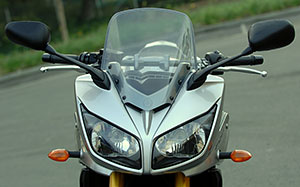
Now, it’s obvious that I wasn’t too happy with the suspension, but on many of the bikes I’ve tested the suspension can be greatly improved once you get some time to really play with the adjustments and get the thing dialed in to work right for your riding style. Meaning that I’m sure the FZ1 could be a great bike for all-around riding if the suspension were the only area where it is lacking. Unfortunately, that is not the case.
Yes, I’m talking about the motor. Now, it may sound pretty cool to tell your buddies that your FZ1 has the same motor as the ’06 R1, but in the real world the motor just doesn’t fit with the character of the bike.
In its original form (the R1), this motor doesn’t make great power in the low-end and midrange, instead saving most of its rush for the highest reaches of the tachometer. The FZ1 has slightly more low-end and midrange than an R1 (and slightly less top-end power), but overall it feels like a letdown compared to what I expect from this style of 1000cc motorcycle, i.e., serious grunt out of corners regardless of where on the tach the needle is pointing.
I first noticed the lack of low-end grunt in our hurried photo session, where I pulled off the stylish wheelie pictured above (yeah, just humor me, ok). Riding a 1000cc standard with an upright seating position like the FZ1, you expect wheelies to be a breeze, but on this bike that is definitely not the case. A major culprit is the tall first gear (comes with the ‘R1-heritage’ package I guess), but even that could be overcome if the bike wasn’t lacking in low-end and midrange torque. I was able to get the FZ1 to wheelie in first gear, but it certainly wasn’t a willing partner in my hooligan antics – I ran it full throttle all the way to redline without lifting the front wheel, which meant I had to add a little bit of clutch work to persuade the front wheel skyward. Second-gear wheelies were not on the menu at all without a healthy wack of clutch combined with a hefty yank upwards on the bars.
Right about now, many of you might be thinking “who cares, I don’t do wheelies anyway”. Well, that may be true, but the lack of wheelie-ability is symptomatic of a greater deficiency in the character of the FZ1’s powerplant.
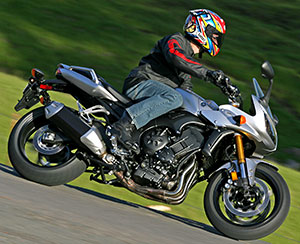
For a big-bore standard, the FZ1 feels distinctly flat and uninspiring anywhere below 7000 rpm. The power delivery is smooth, which is beneficial when riding a moderate pace in the twisties (particularly in low-traction conditions, like maybe pouring rain), but there just isn’t enough grunt to really satisfy the demands of an aggressive rider. I suspect that the FZ1’s extremely tall gearing is at least partially at fault – when Yamaha re-tuned this motor, they should have complimented it with a revised gearbox featuring shorter 1-4 ratios.
The FZ1’s R1 heritage definitely shows through in the manic top-end rush, but the impressive surge of power found between 7000 rpm and the 12000 rpm redline is really in the wrong range of the tach for the type of riding most people will do with this bike. Indeed, I rarely found myself venturing above 8 or 9000 rpm, except when I downshifted to make a pass (which shouldn’t even be necessary on a 1000cc standard).
The new FZ1 sits you almost perfectly upright, and carries only a small fairing to divert some of the airflow. Personally, I think the situation would be much improved with a windscreen about 2 inches taller and 3 inches wider – another minor deficiency easily rectified by the aftermarket. As it is, the bike is fine as long as you don’t go much faster than 85mph – at that point, the wind blast starts to become uncomfortable enough to make you slow back down (come to think of it, that little feature is probably a benefit for someone with as many points on their license as me!).
Other than the odd-shaped bars I mentioned earlier, I have no complaints about the riding position, and I found it perfectly liveable for the 6 or 7 hours I spent on the bike. I did start to notice some ‘saddle-soreness’ about midday, but I’m not sure my experience is representative of how most riders will feel – you see, the dimensions I mentioned earlier (5’9″, 140lbs) don’t leave me much ‘padding’ in my ‘seating area’, and so I find very few seats that feel comfy after several hours.
In the end, the FZ1 seems to be a little bit confused about its purpose in life. Buyers looking at bikes in this category expect powerful grunt from just above idle, with a tractable and powerful midrange to use when riding a moderately aggressive pace. Instead, Yamaha has endowed the FZ1 with a motor that screams on top, but under-delivers in the lower RPM. This might be great for a sportbike, which is designed to be ridden extremely hard through twisty roads or on the track, but for a bike like the FZ1 it’s just not what you’d call ideal.
Of course, the FZ1 is probably one of the best-looking bikes in its class, and provides good comfort for a bike with upright seating and a small fairing. The brakes are very good when compared against its direct competitors, and the suspension might not be set up perfectly ‘off-the-rack’, but the FZ1 provides a wide range of adjustment to help owners fine-tune the bike for their size and riding style – a feature some of its competitors lack. These features (especially the styling) will help the FZ1 continue as a big seller for Yamaha, but we still wish they had equipped it with a motor and transmission that provided more low-down grunt.
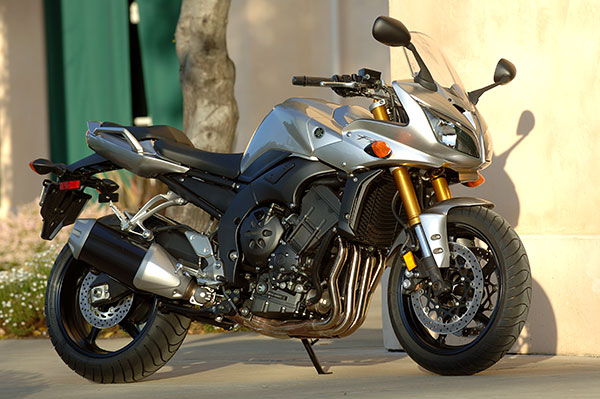
U.S. MSRP of the 2006 Yamaha FZ1 is $9,099. For additional details and specifications, visit Yamaha’s web site here.





